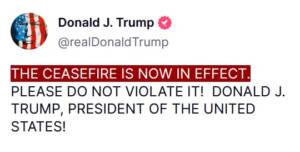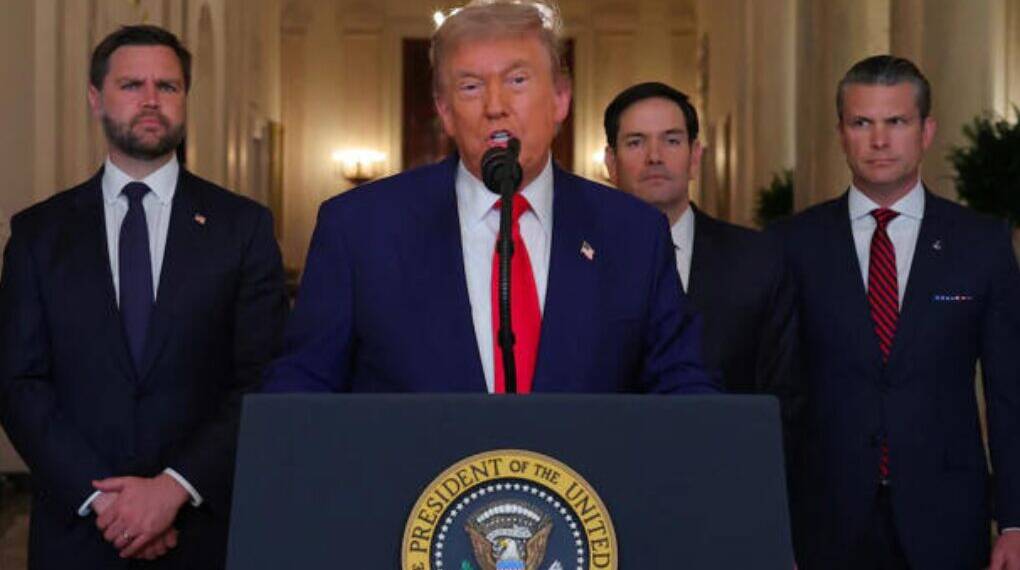U.S. President Donald Trump announced what he termed a “Complete and Total CEASEFIRE” between Israel and Iran, effectively concluding what he called “The 12 Day War.” The announcement, delivered via social media, outlined a phased ceasefire agreement between the two nations. It marks the most public attempt to de-escalate a rapidly intensifying conflict that had drawn regional and international concern.

Ceasefire Structure and Timeline
According to the details shared by Trump, the ceasefire was structured as follows:
Iran initiates a halt in hostilities at hour zero.
Israel follows 12 hours later.
At the 24-hour mark, the ceasefire is declared complete.
This phased approach is atypical in modern ceasefire agreements, which usually demand simultaneous de-escalation to prevent unilateral advantage. The staggered format created a 12-hour interval during which Iran was not constrained by mutual ceasefire terms—raising questions about the operational and strategic implications of this arrangement.
Events Following the Announcement
Within hours of the announcement, reports emerged of renewed Iranian missile attacks that resulted in the deaths of at least seven Israeli civilians. Iranian forces appeared to use the initial phase of the ceasefire to conduct additional operations. By contrast, the Israeli government reportedly abided by the delayed terms and did not retaliate until the agreed 12-hour window had passed.
This sequence of actions suggests that the ceasefire may have been interpreted asymmetrically by the two parties. While Iran may have viewed the initial period as a final opportunity to act before the cessation, Israel appeared to adhere to the announced timeline.
Statements from Regional Actors
Iranian officials issued mixed messages. Some statements suggested a willingness to participate in the ceasefire conditional upon Israeli restraint, while others denied that any formal agreement had been reached. This ambiguity created uncertainty about the level of coordination between the involved parties and whether the ceasefire had the status of an official accord or a verbal understanding.
Israel, for its part, officially announced a ceasefire with Iran and reportedly paused offensive actions according to the 12-hour delay specified by Trump.
Role of the United States and Qatar
Trump positioned himself as the principal negotiator, stating that both Israel and Iran reached out to him independently to request peace. According to sources familiar with the negotiations, Qatar also played a facilitative role. Qatar’s involvement was reportedly triggered after an Iranian missile incident impacted the U.S. base at Al Udeid, prompting diplomatic engagement between Washington, Doha, and Tehran.
The absence of traditional diplomatic channels or third-party verification mechanisms—such as U.N. or IAEA oversight—raises questions about the long-term enforceability of the agreement.
Assessment of the Ceasefire’s Durability
Several indicators suggest that the ceasefire is provisional rather than permanent:
There is no public record of a signed or multilateral agreement.
The terms rely heavily on verbal or informal commitments.
There is no international monitoring or enforcement body assigned.
Hostile rhetoric and military readiness persist on both sides.
While hostilities have temporarily decreased, experts note that such an arrangement lacks the structural and legal features typically required for long-term conflict resolution.
Geopolitical Implications
The conflict and subsequent ceasefire reflect the evolving dynamics of Middle East power politics. Trump’s involvement demonstrates the continued relevance of American influence, particularly in crisis mediation. However, the decentralized and personalized style of diplomacy used in this case contrasts with more traditional models involving multilateral institutions or state departments.
Qatar’s engagement highlights the role that smaller states may play in facilitating dialogue between adversarial powers, especially when larger players are indirectly affected by conflict spillover.
The ceasefire between Israel and Iran, as announced by President Trump, represents a temporary de-escalation of a potentially broader conflict. However, the lack of formal agreements, unilateral interpretations of the timeline, and continued instability suggest that the situation remains volatile. Whether this marks the beginning of a sustainable peace process or merely a pause in hostilities remains to be seen.








